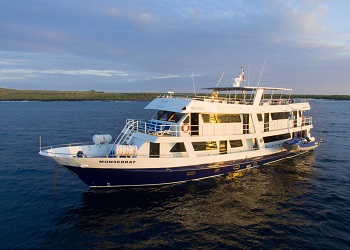Letty Itinerary D - 5 Days
ITINERARY D - 5 DAYS
RIDAY
AM: Baltra: Arrival and Transfer to the boat
AM: Baltra: Bartolome (HK/PR/SN)
SATURDAY
AM: Genovesa: Darwin Bay (HK)
PM: Genovesa: EL Barranco (PR/KY/HK)
SUNDAY
AM: South Plazas Island (HK)
PM: Santa Fe Island (TK/KY/PR)
MONDAY
AM: Santa Cruz: El Chato Tortoise Farm / Twin Craters (HK)
AM: Santa Cruz: Charles Darwin Research Station (HK)
TUESDAY
AM: Santa Cruz: Mosquera Islet (HK)
AM: Baltra: Transfer to the airport
HK: HIKE / SN: SNORKEL / PR: PANGA RIDE / KY: KAYAK /
PB: PADDLE BOARD
DAY 1: FRIDAY
AM: BALTRA ARRIVAL AND TRANSFER TO THE BOAT
The first stop is Baltra, where we will transfer, P,M, Bartolomé 15¦00 – 18¦00h
PM: BARTOLOMÉ
In the afternoon, visit to one of the most iconic Islands in the Archipelago, Bartolome truly a magnificent place to enjoy great snorkeling and breathtaking natural sceneries during the hike, There are have two disembarking possibilities (to be defined with your guide the previous night)¦ the dock, made out of lava and concrete, soon turns into a wooden staircase built to avoid erosion and consists of 372 steps, It takes us to the island's summit, where we find what probably constitutes the most photographed site in the Galapagos¦ Pinnacle Rock, Due to its altitude, the lack of vegetation is immediately noticeable, Pioneer plants are observed, they are called this way because they are the first to establish roots on new ground, Behind the beach, we have the dunes covered by mangroves,
The coralline beach next to Pinnacle Rock is a wet landing site from which we are able to snorkel amongst tropical fish and perhaps sea lions and penguins; they rest on the lava of the intertidal zone and sometimes decide to take a dip, Evening briefing, dinner and overnight on board,
DAY 2: SATURDAY
AM: GENOVESA: DARWIN BAY
Today you will visit one of the most beautiful Islands in the Archipelago, Genovesa Island; wet-landing at Darwin Bay, a sandy coral-beach with a lovely viewpoint of the entire shoe-horse shaped Bay, Fantastic opportunity to spot birdlife like¦ Galapagos hawk, frigate birds, red-footed boobies, mockingbirds, lava gulls, swallow-tailed gulls, Lunch on board your Yacht,
PM: GENOVESA: PRINCE PHILIP'S STEPS
Dry-landing and hike at Prince Philip's Steps to a narrow stretch of land that opens out onto the plateau surrounding Darwin Bay, that extends forming the north side of the island, Riding our dinghy to the far side of the caldera, red-billed tropicbirds display vociferously overhead while Galapagos fur seals can be seen on the shoreline, Once at the top of the rocky stairway we are immediately met by Nazca boobies, red-footed boobies, mockingbirds, and finches that line our way through a palo santo forest until we arrive at an expansive open lava field, Wedge-rumped storm petrels swarm above the lava where we keep our eyes peeled for short-eared owls, Return to the Yacht, Evening briefing, dinner and overnight on board,
DAY 3: SUNDAY
AM: SOUTH PLAZAS
After Breakfast, dry-landing at beautiful South Plaza Island to start hiking through a colorful cactus forest (Opuntia cacti) surrounded by curious sea-lions and marine and yellow-hybrid land iguanas and a generous variety of birdlife¦ tropical bird, Nazca and blue-footed boobies and more, Board the Letty for Lunch,
PM: SANTA FÉ
In the afternoon, wet-landing at the northeast of Santa Fe, hike around endemic cactus forest; be on the lookout for land iguanas, the largest iguana species of Galapagos are found here but also for Galapagos snake, Galapagos hawks, Darwin's finches and mockingbirds, Also possibility to snorkel and swimming, Evening briefing, dinner and overnight on board,
DAY 4: MONDAY
AM: SANTA CRUZ: EL CHATO TWIN CRATERS
Today we will visit the Highlands of Santa Cruz and visit a natural reserve for giant Galapagos tortoises in semi-natural state, they can live up to 200 years and weight over 450 pounds; a wonderful opportunity to share a little bit their habitat, Possibility to visit the Lava Tunnels, which are result of volcanic eruptions millions of years ago,
PM: SANTA CRUZ: CHARLES DARWIN
After Lunch, continue to the Town of Puerto Ayora and to the World's famous Charles Darwin Research Station where you will interact closely with Galapagos giant Tortoises and learn about their different breeding stages from hatching to full-grown adults (over 100 years old specimens); stroll around Puerto Ayora to buy some nice souvenirs and help the local businesses and economy, Return to the Yacht for dinner and overnight,
DAY 5: TUESDAY
AM: MOSQUERA ISLET / BALTRA TRANSFER TO THE AIRPORT
Early in the morning, after Breakfast, visit to Mosquera Islet, a tiny low-lying islet, covered in coral sand, is set between North and South Seymour Islands, It is home of colony of sea lions that come to laze on the soft white sand, It is a good spot to observe shorebirds as well as herons, lava gulls and boobies,
Return to the Yacht and disembark at Baltra Island (around 09h30-10h00) for your flight back to Mainland or end at Itabaca Channel's pier area if you plan to remain for a few more days in the Galapagos, End of services,







